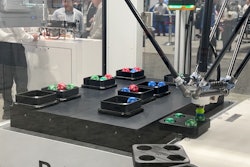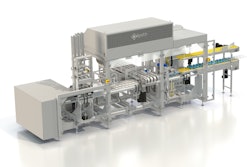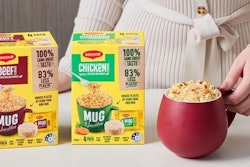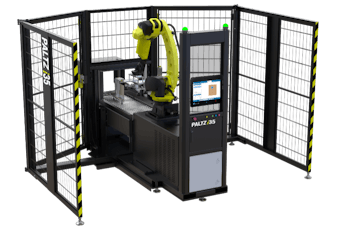In the third installment of our must-see technologies and trends from PACK EXPO International 2022, we welcome the editor-in-chief of OEM Magazine, Stephanie Neil. Loyal listeners of unPACKed with PMMI all know by now that the weakening workforce is a stress across our entire industry, and each editor has touched on that in parts one and two. Stephanie tackles the issue from the point of view of the OEM, who indicate that their customers are now looking to them for help with the unskilled labor force, whether it be with more simple intuitive machines or robots for rent.
To subscribe, rate, review, and find more unPACKED podcast episodes, visit pmmi.org/podcast or find us on Apple Podcasts, Spotify, iHeart Radio or wherever you listen to your podcasts.
 | Read the full transcript below.
|
Sean Riley:
You are listening to unPACKed with PMMI, where we share the latest packaging and processing industry insights, research and innovations to help you advance your business.
Hi, and welcome to unPACKed with PMMI. I'm your host, Sean Riley. In our third installment of our must see technologies and trends from PACK EXPO International 2022, we welcome editor in chief of OEM Magazine, Stephanie Neil. As loyal listeners of the unPACKed podcast. I'm sure that I can trust you not to rat me out to previous guests of our must see technologies and trends podcast series, Matt Reynolds, Michael Costa, Lilián Robayo, or Keren Sookne. As I say, we have saved the best for last. We all know by now that the weakening workforce is a stress across our entire industry, and each editor has touched on that. Stephanie tackles the issue from the point of view of the OEM. OEMs that she talked to at PACK EXPO International 2022 said that now their customers are looking to them for help with the unskilled labor force, whether it be with more simple intuitive machines or robots for rent. Let's have a listen.
Hi and welcome to Must See Technologies and Trends here at PACK EXPO International 2022. I'm your host, Sean Riley, and I am joined today by Stephanie Neil from OEM. Hello, Stephanie.
Stephanie Neil:
Hello.
Sean Riley:
So this is now our fourth day of doing this. Yes. The fourth time we've done this. And I have to think something that's run sort of either as a lead in or through most of whatever all the other editors have brought up so far is things that they've seen on the show floor that inevitably address the labor shortage. So as I guess start off with you Steph, you've been out there now on the floor seeing things. Has anything jumped out at you to sort of solve that problem?
Stephanie Neil:
Yeah, so just to start, we all know that there's a skills crisis in this industry and every single manufacturer I talk to says that they're looking for help and they're looking to their OEMs, their machine builders for help. So the other thing is training. People might come in for six months and leave and move on. So these companies make an investment in people and then they move on. So everybody now is familiar with an iPhone. They can get a video anywhere they want. So a lot of these companies are putting videos on a phone or on HMI. But I did see over at BellatRx, which has a new labeler machine, but it came out specifically here at PACK EXPO with the purpose of helping with the skills shortage. So if you go to the HMI, all the operator has to do with no training at all is to plug in the dimensions of a bottle and diameter, height, size of the bottle, and then the motion control servo drives, synchronize and create a recipe for the setup.
So there's no manual adjust. Well, there is manual adjustment. So then the next step is of course, that they have to do a physical adjustment. So they have lights that are on the machines. So a white light says this is where you need to go to the operator to make that physical adjustment to the set point that just happened on the HMI screen. And then as they're adjusting it, there are arrows that show them what to do and it goes from red to green when it's in the right position. And then the next light comes on and the operator goes through and does the same exercise. So if you do need more help, you can go back, the operator can go back to the HMI and they can click on a video and then it'll show you exactly what they're supposed to do. So this really helps streamline the process, it helps, it makes it easier for anybody to be an operator. I talked to somebody about a week ago who said that they're like a service tech and somebody called to say, help with my machine. And they were trying to gauge their familiarity with the machine and the person said, "well, I was a cashier about an hour ago in our retail side, and now I'm a machine operator." So that's what we're dealing with. And the machine builders have to put more usability into their systems.
Sean Riley:
Yeah. And that's a fascinating example. I hadn't heard it to that depth. I've heard people using the phone lights, HMIs just because we all know how to use a phone. And this generation that's coming into the workforce obviously knows how to work off of a phone, but I hadn't heard it even being taken steps further with the lights and stuff like that. So that is very interesting that that would be something that the machinists have taken into consideration when building the operating systems for the packaging machine. Steph, how about something else that you saw on the show floor?
Stephanie Neil:
Well, I will talk about something else that I saw at the show, but I just want to continue this conversation-
Sean Riley:
Sure [inaudible 00:05:24] that.
Stephanie Neil:
...a little bit with a little bit of a different angle. And again, because of the labor shortage and because of the complexity of, manufacturers want the complexity all under the hood of the system and they want it to be easy to use. Also, it can be cost prohibitive to buy a new machine or a new robot. So I recently did a story in OEM Magazine about a company called Frain Industries where they have just completely changed their business model and they're buying machines from other OEMs and then they're renting them out. So there's a lot of great startups on the show floor and there's one called Formic. It's a two year old company and they're taking that same concept, but they're doing it with robots and they're introducing here at the show a robot Palletizer.
And the co-founder of this company worked at a robot company before and saw that even with the collaborative robot, it's cost prohibitive because it might cost, I don't know, 10, $20,000. But once you integrate it with everything and you have to do the maintenance and you have to do the programming, now it becomes a much larger investment. So for small and mid-size manufacturers as well as for co packers and co-manufacturers that are dealing with many different companies and many different products, it might be easier to rent a robot. So the whole robot as a service theme came up and we've talked about it, we've talked about it last year, but I'm seeing more and more on the show floor of these types of concepts where this company, Formic will work with the robot supplier and they'll work with machine builders and system integrators. They'll design a custom robot for a customer and then they'll buy the robot and then they'll rent it to the small manufacturer.
And so it's an hourly rate and they're paying for productivity and if the robot's not in use, the company doesn't get paid. So it's in their best interest to keep the robot up and running. So there's an edge device installed in each robot that's sending data back to the technicians at the robot supplier company, and they're watching this and proactively calling the end user to say, listen, there's something wrong here. We need to take care of this before there's any downtime. Downtime is bad for the customer, downtime's bad for this robot supplier that is basically calling themselves a robot staffing agency.
Sean Riley:
That's really interesting. And for some reason, I'm thinking also of with everyone dealing with supply chain issues, if they're waiting on something, could you fill in with that robot until something you like, say you're getting a robot down the road, could you use that while that is being built in the meantime?
Stephanie Neil:
Yep. You could. He said that people definitely can give it back if they don't [inaudible 00:08:26] -
Sean Riley:
That's what I was thinking like is-
Stephanie Neil:
They can bring it in temporarily and then give it back if they don't want it. But the majority of people, he said, it's only a two year old company. They do have customers, but he's saying that the customers that they have are after a month asking for another machine.
Sean Riley:
That's fantastic. Very cool. Anything else on the show floor that you would like to share?
Stephanie Neil:
Well, I just think in general I'm seeing a lot more integration. There's some of the companies over at the ProMach booth that are, and I do have other stuff, but just in general, I just wanted to say I'm seeing a lot more integration of different types of capabilities and being able to even applying labels, being able to apply it in all sides of the package and all different sizes. And those are things that are going to help in e-commerce applications and warehouse applications. So that's just another thing that I'm seeing out there.
Sean Riley:
Okay. With that being said, I'd like to thank you all for attending and I'd like to thank Steph for coming up here and thank you for attending our session here at PACK EXPO 2022.
Please rate, review and subscribe. To do that, go to the iTunes podcast or Spotify app on your phone and search for unPACKed with PMMI























